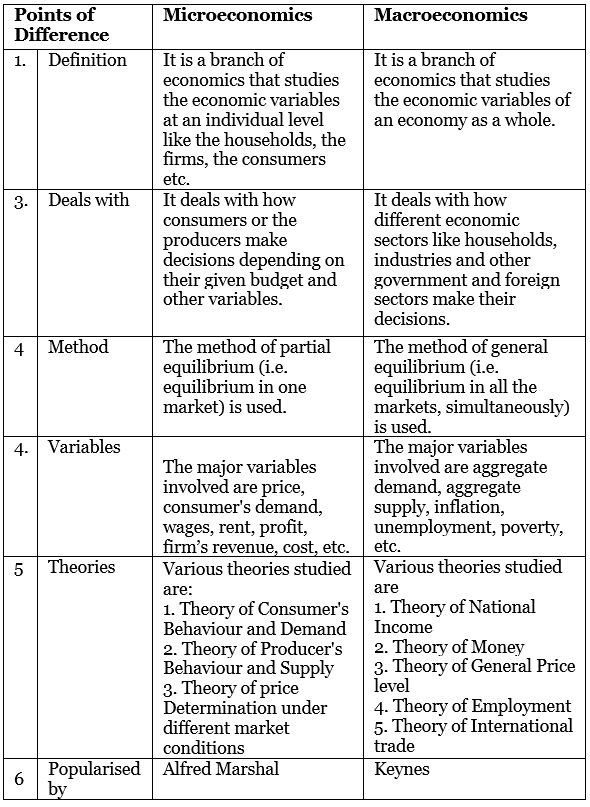NCERT Solutions for Class 12 Economics - Introduction (Macroeconomics)
Q1: What is the difference between microeconomics and macroeconomics?
Ans:

Q2: What are the important features of a capitalist economy?
Ans:
Capitalist economy is an economic system where the means of production are privately owned. These means of production are driven by the motive of profit making. This economic structure is also known as free market economy or laissez faire.
Following are the features of a capitalist economy:
- Role of the government: The government provides the basic framework for the smooth functioning of an economy. It provides the basic framework and is responsible for maintenance of law and order, justice, growth and stability, defence, etc.
- Profit motive: The economic agents are driven by the prime motive of profit maximization.
- Central problems: The central problems of an economy are solved by the market forces of demand and supply, i.e., the law of demand and supply operates here. The producers will supply only those goods and services that are demanded by the economy.
- Role of private sector: The role of private individuals is more dominant. The main role of undertaking production and organising factors of production are played by the private individuals and capitalists.
- Laissez-faire: This economy is also called `laissez faire’. It has minimum interference or restriction from the government.
Q3: Describe the four major sectors in an economy according to the macroeconomic point of view.
Ans: The four major sectors of an economy according to the macroeconomic point of view are:
(i) Households
(ii) Firms
(iii) Government
(iv) External sector
These can be represented in the following flow chart:

(i) Households: Households buy goods and services for consumption and also supply factors of production like land, labour, capital, and entrepreneur. Households provide the market for the output of the firms.
(ii) Firms: Firms are economic units that carry out the production. They employ and organise factors of production and undertake production process for the motive of profit making.
(iii) Government: A state/government provides law and order, maintains growth and stability and provides administrative services. The main motive of a government is to undertake developmental projects such as dams, roads, heavy industries that usually have long gestation periods. The government invests in education, health sector and provides these services at nominal price. The motive of a government is to serve and not to make profits.
(iv) External sector: This sector is engaged in export and import (external trade) of goods and services. If domestically produced goods and services are sold to the rest of the world, then it is called export. If the goods and services are purchased from the rest of the world, then it is called import.
Q4: Describe the Great Depression of 1929.
Ans: The Great Depression was a severe economic crisis that started in the year 1929. It originated in the United States of America with the crash of the stock market and gradually spread to other countries of the world. The main cause behind this crisis was the fall in aggregate demand due to under consumption and over investment. Due to under consumption and over investment the stock of finished goods started piling up, which resulted in low price level and consequently the low profit level. The money in the economy was converted into unsold stock of finished goods that lead to an acute fall in employment and hence income level fell drastically. The demand for goods in the economy was so low that the production was lowered leading to the unemployment. In USA, the rate of unemployment increased from 3% to 25%.
The Great depression has its own implications and importance in economics, as it leads to the failure of the classical approach of economics. Those who believed in the market forces of demand and supply, paved the way for emergence of the Keynesian approach. It was this incident that provided the economists with sufficient evidence to recognise macroeconomics as a separate branch of economics.
The cause and effect relationship of the Great Depression can be summed up in this flow chart.
Low demand → over investment → low level of employment → low level of output → low income → low demand.
|
64 videos|275 docs|52 tests
|
FAQs on NCERT Solutions for Class 12 Economics - Introduction (Macroeconomics)
| 1. What is the importance of studying macroeconomics? |  |
| 2. What are the key differences between microeconomics and macroeconomics? |  |
| 3. How does government intervention impact macroeconomic variables? |  |
| 4. What are the main goals of macroeconomic policy? |  |
| 5. How does international trade affect macroeconomics? |  |

|
Explore Courses for Commerce exam
|

|


















